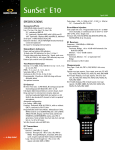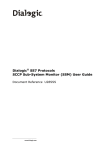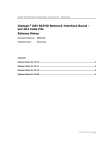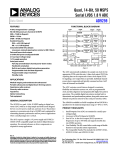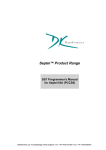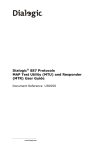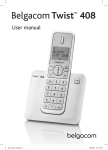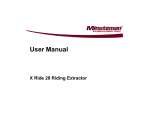Download SS7 Binary for SPCI2S and SPCI4 Release Notes for
Transcript
SS7 Binary for SPCI2S and SPCI4 Release Notes for Version 1.09 1. Overview This release enhances flexibility by allowing the ISUP protocol to be activated when using a TUP licence button. It allows reduced inventory by allowing customers to stock just TUP licence buttons for deployment of both TUP or ISUP systems. The software is backwards compatible with the previous release. 2. New functionality 2.1 ISUP Licensing ISUP licensing has been enhanced so that in addition to being able to be used in conjunction all the existing ISUP licence buttons, it is now possible to run the ISUP protocol using TUP licence buttons. When using this combination it is essential to specify the <run_mode> explicitly in the SS7_BOARD command in config.txt. Note: Whilst it is possible to run ISUP or TUP protocols, it is not possible to run both TUP and ISUP at the same time. 3. Configuration Detail 3.1 Support for 48kbit/s operation Support for 48kbit/s operation was added in the V1.03 release. Configuration information is detailed here prior to inclusion in the Programmer’s Manual. 48kbit/s mode is selected by the Board Configuration Request MGT_MSG_CONFIG0. The data rate is selected by the per-link flags (linkn_flags) field as follows: Bit 11 Bit 10 0 0 64kbit/s 0 1 48kbit/s 1 1 56kbit/s Dialogic Corporation 22-Apr-05 Revised 12-Jul-06 Data Rate SS7 Binary for SPCI2S and SPCI4 Release Notes for Version 1.10 1. Overview This release adds support for two new, low density, run modes for telephony applications. It also adds support for a number of new MAP services and IS41 WIN operations. The release also includes maintenance updates to MTP, ISUP, TUP, SCCP, TCAP, MAP, and IS41 protocol software as detailed below. The software is backwards compatible with the previous release although users should refer to section 3.1 below to ensure that existing applications satisfy the current guidelines and do not set the most significant bit in the id field of the Transmit Request message. 2. New Functionality 2.1 New run_modes – ISUP-S and TUP-S This release introduces two new run modes offering support for lower density telephony applications. In each case the run_mode supports up to 2 signalling links and 1024 circuits, 44 circuit groups. The new modes are selected using the <run_mode> parameter in the SS7_BOARD command in config.txt. Note: Current versions of s7_mgt do not recognise the mnemonics ISUP-S and TUP-S so the user must specify the numerical form of the run mode as detailed in the table below: run_mode numeric value run_mode mnemonic (future use) Description 25 ISUP-S ISUP, 2 signalling links and 1024 circuits. 26 TUP-S TUP, 2 signalling links and 1024 circuits. The syntax of the SS7_BOARD command is: SS7_BOARD <board_id> <board_type> <flags> <code_file> <run_mode> An example to use the ISUP-S run_mode: SS7_BOARD 0 SPCI4 0x0043 ss7.dc3 25 2.2 MTP - Support for Japan operation This release includes additional support for Japan-specific MTP operation including using the least significant bit of the SLS for Link Set selection, and support for multiple DPC in received TFP/TFA messages. For correct operation the unit must be configured both for 16 bit point codes and Japanese operation by setting bits 20 and 21 respectively in the <options> field of the MTP_CONFIG command. 2.3 ISUP - Automatic Blocking of Circuit Groups A new per circuit group option, ISPX1GOP_AUTO_BLK (bit 9), has been added to the ext_1_options field in the Configure Circuit Group Request message (0x7701) to determine whether automatic blocking should be performed for the circuit group. If the option is set, automatic blocking of circuits will be performed for the circuit group and heartbeat messages will be generated and sent to the user application. If the option is not set, automatic blocking of circuits will not be performed for the circuit group and heartbeat messages will not be sent to the user application. Further details of this feature are available on request. 2.4 MAP - New MAP Services. The following MAP services are now supported: MAP-CHECK-IMEI (V1 and V2) MAP-PROVIDE-SUBSCRIBER-LOCATION (V3) MAP-SUBSCRIBER-LOCATION-REPORT (V3) MAP-ACTIVATE-SS (V1 and V2) MAP-DEACTIVATE-SS (V1 and V2) MAP-ANYTIME-SUBSCRIPTION-INTERROGATION (V3) MAP-ERASE-SS (V1 and V2) MAP-REGISTER-SS (V1 and V2) MAP-ANYTIME-SUBSCRIPTION-INTERROGATION, MAP-REGISTER_SS and MAP_ERASE_SS. MAP-GET-PASSWORD MAP-REGISTER-PASSWORD MAP-RESTORE-DATA MAP-RESUME-CALL-HANDLING These services are described in MAP Programmer’s Manual Issue 9. 2.5 IS41 - New WIN operations New WIN operations are supported by the IS41 module: ORREQ, ANALYZD, CONNRES, DISCONNRES, CONNFAILRPT, CCDIR, BULKDISCONNECT, TNOANSWER, TBUSY, TANSWER, OANSWER, TDISCONNECT, ODISCONNECT. Unidirectional dialogues are now also supported, through new IS41DT_UNI_REQ and IS41DT_UNI_IND primitives. 2.6 IS41 - Improved fault diagnostic When a problem occurred in IS41, there was not much diagnostic information given. New software event Error codes have been added for “Unknown Primitives”, “Missing Mandatory Parameter” and “Unknown Parameter” (IS41SWE_USER_MAND_MISSING, IS41SWE_TCAP_MAND_MISSING, IS41SWE_BAD_USER_PRIM, IS41SWE_BAD_TCAP_PRIM, IS41SWE_USER_PAR_FMT_ERR, IS41SWE_TCAP_PAR_FMT_ERR, IS41SWE_USER_UNREC_PARAM, IS41SWE_TCAP_UNREC_PARAM. Software events now also contain extra information, like the dialogue ID (in the id field), as well as the primitive type or the parameter type as appropriate. Refer to IS41 Programmer’s Manual for more information. Note that, as some general software events codes have been replaced by more meaningful error codes, the module is backward incompatible with previous releases: the application will receive for the same error conditions other software event codes, or, if the application only enabled the old software event codes, it would now miss some software event codes. 2.7 IS41 - Selective tracing A new selective tracing mechanism has been added. For certain maintenance and software events (e.g. when a badly formatted message is received) a trace of the message causing the event may now optionally be made. This allows for easier diagnosis of problems. To activate the selective tracing, the user must format and send to IS41 the Set Selective Trace Mask request, setting the appropriate bits in the mask for the types of events that should produce a message trace. If the selected event occurs, a Selective Trace Event Indication, message will be sent to the module configured to receive these traces. 2.8 IS41 - Timer Configuration The default timers for the SMS operations have been changed according to IS41-6. All timers can now also be changed by the application from 0 seconds to 1800 seconds. The len parameter of the timer can now also be set to 0 to indicate to TCAP not to start a timer for this operation. This is needed for instance for operations which require unidirectional dialogues. 3. Other Changes 3.1 ISUP - Change in use of id field The most significant bit of the id field in the Transmit Request is no longer ignored. Early versions of the ISUP module required the most significant bit to be set for outgoing calls so that an id value of 0x8001, for example, would be used to indicate an outgoing call on circuit id 1. In more recent versions, this bit has been ignored by the ISUP module, so that either 0x8001 or 0x0001 could be used to indicate an outgoing call on circuit id 1. In this release, the most significant bit is considered to be part of the circuit id so that an id value of 0x8001 indicates a call (in either direction) on circuit id 32769, which is an invalid value for this binary. Note: Before installing this release, ISUP users should check their applications to ensure that the most significant bit of the id field is not used to indicate an outgoing call. 3.2 ISUP - Support for “EOOP” in TXA messages (SSURF) The “End of optional parameters” parameter is now supported in the TXA message. In versions of SSURF where optional parameters may be included in this message this could cause the TXA message to be subsequently discarded. 3.3 TCAP - Disable operation timer The TCAP operation timer can be disabled (so that no timer is started for a specific operation) by specifying a len=0 for the TCPPN_timeout parameter. 3.4 ISUP - Missing ISP_MSG_CGSC_IND Message In previous software release, if MTP_RESUME was received by ISUP while the ISUP module was still processing MTP_PAUSE (gapping), no ISP_MSG_CGSC_IND was sent by the ISUP module for the MTP_RESUME. This error has now been corrected. 3.5 ISUP - Handling of CGB and CGU Messages (ANSI) For ANSI operations only, the ISUP module now handles receipt of CGB and CGU messages and the corresponding acknowledgement messages with the range field set to zero. Prior to this release, when such messages were received this caused the received message e.g. CGB to be subsequently discarded and a maintenance event was also reported indicating that a message was received for an incorrect range. Also The CGBA message is now sent in the same format as the CGB, i.e. with a range = 0 if the CGB had a range = 0. 3.6 ISUP - Correction to Reset and blocking In previous software release, if a RSC request was followed by a BLO request, the user application did not always get the BLA. This error has now been corrected. 3.7 ISUP - Unblocking Single Circuit When the user sends a CSGC_REQ to unblock a single circuit in the IDLE state, a maintenance event, ISP_MSG_MAINT_IND, 0x070a, with status CCm_BLS_Bad_CGU (0x3e) is now reported to indicate that this is unexpected. Previously, no indication was reported to inform the user application of this event. 3.8 SCCP - SCCP Reset Module In previous software release, the SCCP module was not confirming a SCP_MSG_RESET received before SCP_MSG_CONFIG. SCP_MSG_RESET was also resetting the module id to 0. SCP_MSG_RESET is now correctly handled at any time, independently of SCP_MSG_CONFIG. It does not reset the module id of the module anymore. The module id is unchanged by SCP_MSG_RESET. 3.9 SCCP - Global Title Translation In previous software release, the SCCP module did not translate correctly a primary or backup address coded “BCD, odd number of digits” and not containing any digits in the GT address information. This fault has now been corrected. 3.10 TCAP - Increased subsystem resources The tid_ninst module configuration parameter is used to specify the number of bits that are used for the TCAP instance in the locally generated transaction ID. It is now possible for the number of bits to be zero where multiple instances of TCAP are not used. Previously, configuring the tid_ninst field to be zero resulted in incorrect operation where messages were sent to non-existent TCAP instances. 3.11 TCAP - Timer for UNI operations UNI operations do not expect any response or reject from the network. In previous release, a timer was started for UNI operations, and always expiring. This has now been fixed, and no timer is started for UNI operations (independently of TCPPN_timeout parameter). The dialogue is released once the invoke message has been sent to SCCP. 3.12 TCAP - Module Reset In previous software release, the TCAP module was not confirming a TCP_MSG_RESET received before TCP_MSG_CONFIG. TCP_MSG_RESET was also resetting the module id to 0. TCP_MSG_RESET is now correctly handled at any time, independently of TCP_MSG_CONFIG. It does not reset the module id of the module anymore. The module id is unchanged by TCP_MSG_RESET. 3.13 TCAP - Length Long Form In previous software release, the module did not handle correctly the reception of an element whose length is badly coded in the long form. This error has now been corrected, and the module will send in such a case a Maintenance event TCPEV_SYNTAX_ERR. 3.14 TCAP - Support 5 bits Sequence Control. In previous software release, when sequence control is used (bit 1 of the Indicator Octet of TCPPN_QOS parameter set) the sequence control key in the SCPPN_SEQ_CTRL parameter sent to SCCP was limited to 4 bits (i.e. had a range 0 to 0x0f). This could lead in some situations to inappropriate SLS values being generated and therefore incorrect load balancing across links within a linkset. In this release the sequence control key has been enhanced to 5 bits (i.e. a range from 0 to 0x1f), to provide the full range of the sequence control values supported by the SCCP module. 3.15 MAP - Recovery of MSISDN in ProcessUnstructuredSS-Request The MSISDN parameter is now passed to the user when a MAP-PROUNSTR-SS-REQ indication is received. Previously, in V2 MAP, the parameter was discarded. V1 MAP is unaffected by this problem as the parameter is not supported in V1 MAP. 3.16 MAP - Handling missing Parameter in Service Request from User In the previous version of MAP, an access violation could be observed if MAPPN_sm_rp_da was missing in a MAPST_FWD_SM_REQ. This error has now been corrected. 3.17 MAP - Enhanced (DE)ACTIVATE-SS The parameters MAPPN_per_call_basis, MAPPN_not_to_held_ret_party, MAPPN_user_to_user_serv_ind, MAPPN_max_conf_nbr and MAPPN_hunt_group_access_sel_order may now be included by the user in MAPST_ACTIVATE_SS_RSP(V1) and MAPST_DEACTIVATE_SS_RSP(V1); it may also be present in the following primitives; MAPST_ACTIVATE_SS_CNF(V1) and MAPST_DEACTIVATE_SS_CNF(V1). 3.18 MAP - Pre-arranged end In previous releases, MAP did not correctly handle pre-arranged end, as MAP ended the dialogue immediately on reception of a MAPCLOSE-REQ containing a pre-arranged end, and did not notify the MAP-user. This has now been corrected, and, on pre-arranged end, dialogues are being closed after any services awaiting results have either timed out or received a result. When this happens the MAP user is informed and knows that the dialogue has been closed through a MAP_CLOSE_IND containing a MAPPN_release_confirm parameter set to MAPRC_rel_confirmed. To preserve full backward compatibility, the MAP-user can configure the MAP module to handle pre-arranged end as in previous software release (where MAP closed dialogues immediately on reception of CLOSE_REQ, whether the dialogues are active or not) by setting the MAPF_NO_PREARRANGED_END bit in the option field of MAP_MSG_CONFIG. 3.19 IS41 - Check on number of invokes configured A check is now made on the maximum number of invokes specified in the Configure IS41 request message to make sure that it is not larger than the maximum allowed. If an incorrect value is specified, the Configure IS41 request message is now discarded and a status of “bad parameter” is returned. Previously, no check was made which could occasionally cause the board to reset if an incorrect value was specified. 3.20 IS41 - Indefinite length encoding Handling of a message received with indefinite length encoding could occasionally cause problems if a zero length parameter was included. The message would not be decoded correctly and Provider error = 9 (invalid response received) would be included in the message sent to the application. This problem no longer occurs. 3.21 IS41 - Fixed internal signal overflow When handling many invokes at the same time, the system could run out of internal signals, which could result in out of invokes. This has now been corrected. 3.22 IS41 - Fixed QoS Handling If IS41 received a TCP_MSG_DLG_IND from TCAP with the TCPPN_QOS parameter set to other that 2 (Sequence control requested only), the message was discarded and a software event indication (IS41SWE_TCAP_BAD_FMT) was sent to user. This has been corrected. 3.23 IS41 - Fixed User Abort from TCAP IS41 did not properly handle correctly formatted TCPPT_TC_U_ABORT indications from the network if they had no parameters. This has been corrected. Also, TCPPTA_TC_U_ABORT was not properly handled in some states. It is now handled in all states. 3.24 IS41 - Handling of syntax error in component from TCAP IS41 did not properly handle syntax errors in component received from TCAP. It tried to send TCPPT_TC_U_REJECT if it discovered a syntax error in a component received from TCAP, even when TCAP had already sent TCPPTA_TC_RESPONSE. This has been fixed, and IS41 does not try anymore to send a TCPPT_TC_U_REJECT after having received TCPPTA_TC_RESPONSE. 3.25 IS41 - Improve PermissionToRelease PermissionToRelease has been improved. All supported operations now set the PermissionToRelease to true, except ConnectResource and DisconnectResource operations, for which PermissionToRelease is set to false in the invokes and to true in the responses. 3.26 IS41 - Support for Extra Parameters The previous version of IS41 would not support the reception of extra (non supported) parameters in service requests and indications. This resulted in these parameters not being passed to the user application or to TCAP. A new parameter, IS41PN_ellipsis, has been added. Unknown parameters in operations received from TCAP will be passed to the user application as an IS41PN_ellipsis parameter. The user application can also add an IS41PN_ellipsis parameter in a service request to use any unsupported parameters in supported operations. Parameter name IS41PN_ellipsis Parameter length Variable, in the range 2 to 220. Parameter data Series of parameters in tag, length, data format as defined by the users. Dialogic Corporation 16-Aug-05 SS7 Binary for SPCI2S and SPCI4 Release Notes for Version 1.11 1. Overview This is a maintenance release including updates to MTP, SCCP, TCAP, and MAP protocol software. It includes support for dynamic addition of MTP routes and adds support for the MAP MAP-SENDAUTHENTICATION-INFO service. The release includes a number of minor corrections as detailed below. It is fully backwards compatible with the previous release 2. New functionality 2.1 MTP - Dynamic Route Addition This release allows MTP routes to be added, removed and modified dynamically without impact on operation of other routes. Dynamic addition and modification uses the existing MTP Route configuration message and a new message is defined to allow removal of MTP routes. Both messages are fully documented in the MTP3 Programmer’s Manual, Issue 6. 2.2 MAP - New and Updated MAP Services The MAP-SEND-AUTHENTICATION-INFO service is now supported with application context V3. Additional parameters are now supported in MAP-SEND-IDENTIFICATION service when using application context V3. Prior to the next release of the MAP Programmer’s Manual, users can obtain details of the API for these services on request. 2.3 MAP – Read Module Status A new message, Read Module Status (MAP_MSG_R_MOD_STATUS, 0x67ee) has been added. This message allows the user to query the MAP module to determine its current internal resource usage. The maximum allocated resource count can be reset or left unchanged depending on the setting of the status field. The user should send the message with the version initialised as shown above and all other fields set to zero. The confirmation message (0x27ee) returned by the MAP module will contain a snapshot of the status of the module. MESSAGE HEADER FIELD NAME MEANING type MAP_MSG_R_MOD_STATUS (0x67ee) id 0 src Management module id dst MAP_TASK_ID rsp_req Sending layer’s bit must be set hclass 0 status 0 = Leave maximum unchanged 1 = Reset maximum after reading err_info 0 len 40 PARAMETER AREA OFFSET SIZE NAME 0 1 version – set to zero 1 3 pad – set to zero 4 4 num_ic_dlg - Number of incoming dialogues. 6 4 num_og_dlg - Number of outgoing dialogues. 12 4 num_act_invokes - Number of active invokes 16 4 num_alloc_dbuf – Number of allocated dialogue buffers 20 4 max_alloc_dbuf - Maximum number of allocated dialogue buffers since module start-up or since last count reset. 24 16 reserved – must be set to zero The following table describes two new error codes that may be indicated in the status field(–s) in the MAP_MSG_R_MOD_STATUS confirmation message (0x27ee). Value (Dec) Mnemonic Description 10 MAPE_INVALID_VERSION MAPinappropriate or invalid message version. 11 MAPE_BAD_LENGTH MAP inappropriate or incorrect message length e.g. message exceeds defined length. 2.4 TCAP - Support for TC-RESULT_NL On receipt of TC-RESULT-NL, MAP will now buffer the data and wait for further TC-RESULT-NL until a TC-RESULT-L is received. If the assembly of TC-RESULT-NL and TC-RESULT-L causes the message length to exceed the, supported maximum of 320 bytes the TC- RESULT-NL data will be discarded and a Software Event Indication with a status code MAPSWE_TC_RESULT_NL_TOO_BIG (24) will be sent to management. If more than the configured number of TC-RESULT-NL are received in parallel on different dialogues, subsequent TC-RESULT-NL will be rejected and a new Software Event Indication with status code MAPSWE_NO_DBUF (22) will be sent to management. Previously, the receipt of TC-RESULT-NL was not handled by MAP and when received this caused TC-REJECT messages to be sent to the network. Four new error codes have been added to the Software Event Indication (MAP_MSG_ERROR_IND, 0x07e9) message as detailed in the following table: Code Mnemonic Id Diag1 Description 21 MAPSWE_DBUF_LOW 0 0 The internal pool of MAP_DBUF message buffers is running short of entries. 22 MAPSWE_NO_DBUF 0 0 The pool of MAP_DBUF message buffers has been exhausted. 23 MAPSWE_DBUF_ABMT 0 0 Number of MAP_DBUF structures recovered. 24 MAPSWE_TC_RESULT _NL_TOO_BIG User Dialogue id 0 Re-assembled message exceeds maximum message length. 3. Other Changes 3.1 MTP - Rerouting buffer management This release incorporates enhancements to the management of the MTP3 rerouting buffers in order to reduce the chances of the buffer contents being discarded due to overload. The rerouting buffers are used during the Forced Rerouting and Controlled Rerouting procedures and typically hold up to about 1 second worth of traffic which under load may be a significant number of messages. If the total number of messages stored causes the system to go into overload then messages are discarded and an event indication (MGT_MSG_EVENT_IND) is generated by MTP3 with an error_code of 0x67 (MTP_RRT_OVRFLW). Recovery from this condition is fully automatic. Previously a fixed, relatively low, threshold was used to determine when to discard messages. 3.2 ISUP - T38 circuit group option Timer T38 (waiting for Resume) is now correctly handled and will now only be initiated if the per-circuit group ISPX1GOP_T38 (bit 5) option is set. Previously, the timer T38 was initiated regardless of the option setting. 3.3 ISUP - Custom parameter mechanism The custom parameter mechanism now allows the user to select any of the existing supported variants as the base variant when configuring a custom variant. In previous software releases only ITU could be specified as the base variant – selecting any other variant could have caused the system to become unstable. 3.4 ISUP - Handling of RLC under abnormal release condition When ISUP must release a call under abnormal conditions e.g. on timer expiry, if the user sends REL followed by RLC, the RLC is no longer passed to the network. In previous releases, the user RLC was passed to the network and Release indications were also sent to the network to indicate that an RLC from the network was required to idle the circuit. 3.5 ISUP - RLC does not idle circuit In previous software releases when the user sent a reset request for a single circuit and before the reset was acknowledged by RLC, if ISUP subsequently received and acknowledged a reset (RSC), from the network, then the RLC message in response to the user circuit reset request was ignored and ISUP continued to send RSC to the network. This issue has been resolved such that, in the described condition, ISUP will correctly identify the RLC from the network as a response to the user circuit reset request and ISUP will return the appropriate circuit to the idle state. 3.6 SCCP - Support 8 bit SLS In previous software releases, the SLS value was limited to 5 bits when the per-module SCPF_24PC runtime option was set and to 4 bits for all other cases. A new runtime option, SCPXF_8BITS_SLS (bit 6), has been added to the extended options parameter of the SCCP Configuration Request (0x7740) message. If both the new SCPXF_8BITS_SLS option and the SCPF_24PC option are set, the SLS will now be encoded using 8 bits. 3.7 SCCP - Point Code in Calling Party Address In previous software release, when SCCP received a message from MTP, it always added a Point Code in the Calling Party (If the calling address does not contain a point code, the point code was recovered from the MTP label). There was no way to prevent this PC insertion. A new runtime option, SCPXF_NO_CALLING_PC (bit 8), has been added to the extended options parameter of the SCCP Configuration Request (0x7740) message. If the new SCPXF_NO_CALLING_PC option is set, the point code will not be inserted. 3.8 SCCP - Extended Management Message Encoding The handling of Extended Management messages has been corrected to ensure the affected PC parameter is encoded with the least significant byte (LSB) first. This will match the encoding described in the SCCP Programmer’s Manual. This only has any effect when the extended management indications are in use. 3.9 SCCP - Missing NOTICE_IND In the previous release, if an error occurred when handling an SCP_MSG_TX_REQ message with the return option set, an SCPPT_N_NOTICE_IND was not always sent to the SCCP-User. 3.10 TCAP - Component Resource Loss Under some error cases such as the reception of a Return Error from a Class 4 operation a loss component buffer resource could be experienced. In this situation the user would then see the TCAP Software event TCPSWE_NO_TCPT. This release modifies the component handling to rectify this fault. In some cases this fault could result in a total loss of all component resources. 3.11 MAP - MAP_ERROR_IND id field In previous software releases, when the error indication was MAPSWE_USER_MSG_UNEXP (0x13), the Id field in MAP_ERROR_IND was not correctly set to the dialogue ID. This has now been corrected. 3.12 MAP - Missing CLOSE_IND In previous software releases, if a CLOSE_REQ was initiated in the INIT state with all invokes responded or timed out, then no CLOSE_IND were issued. This issue has now been corrected and a CLOSE_IND is sent when the MAPF_NO_PREARRANGED_END flag of MAP_MSG_CONFIG had not been set. If the MAPF_NO_PREARRANGED_END flag has been set, then no CLOSE_IND is being sent to preserve backward compatibility. 3.13 MAP - MAP-SEND-IDENTIFICATION In the previous release, the TMSI parameter in MAP-SENDIDENTIFICATION V3 was incorrectly coded as an object string tag and not an object string in a sequence. This meant that the MAP-SENDSEND-IDENTIFICATION V3 request message would be discarded by the remote MAP for having an incorrect format. Similarly, if an indication had been received with the correct tag, MAP would discard the message. A similar issue existed with responses and confirmations. This has now been rectified. V1 and V2 MAP were unaffected by this problem. Dialogic Corporation 01-Mar-06 Revised 12-Jul-06 SS7 Binary for SPCI2S and SPCI4 Release Notes for Version 1.12 1. Overview This is a maintenance release including updates to the ISUP and MAP protocol software. This release includes enchancements to the SCCP Maintenance Events message and a correction to UK ISUP's handling of the National Forward Call Indicator (link by link) parameter. The release also includes a number of minor corrections as detailed below. This release is fully backwards compatible with the previous release. 2. New functionality 2.1 ISUP - Cause Parameter Location values The ISUP protocol software now supports the full range of location values in the cause parameter. The user must configure the required location value using the new per-circuit group options, ISPX1GOP_SET_LOC and ISPX1GOP_LOC (bits 11 -15 of the <ext_1_options> field in the Configure Circuit Group Request message) at run-time as follows: Bit Number 11 Mnemonic ISPX1GOP_SET_LOC Description Used in conjunction with ISPX1GOP_LOC to set the location value to be indicated in the cause parameter. If set to 1, the location value in the cause parameter will be determined by the 4-bit ISPX1GOP_LOC option. Otherwise the location value will be set to a value of 5 “Private network, remote user (RPN)” 12-15 ISPX1GOP_LOC Sets the location value to be indicated in the cause parameter during call release. The following cause location values are defined: 0x00 - “User (U)” 0x01 - “Private network, local user (LPN)” 0x02 - “Public network, local user (LN)” 0x03 - “Transit network (TN)” 0x04 - “Public network, remote user (RLN)” 0x05 - “Private network, remote user (RPN)” 0x07 - “International (INTL)” 0x0a - “Beyond interworking point (BI)” 2.2 SCCP - Additional Information in Maintenance events Additional information may be added in the parameter area of the SCCP Maintenance Event Indication message (SCP_MSG_MAINT_IND 0x0761), giving more detailed information for the event including a cause value and additional parameters where appropriate. The following is an example message parameter area showing the SCPEV_RTF_SS_CONG maintenance indication. Parameter Area OFFSET SIZE NAME 0 1 Cause value 1 3 Point code of replicate sub-system (note least significant byte first as per Q.713) 4 1 Sub-system number 5 1 Message Priority 6 1 Congestion Level The table below lists all of the maintenance indications together with the list of parameters support by that indication. Maintenance event code Len Cause value 1 SCPEV_RTF_TTYPE 1 0 2 SCPEV_RTF_TVAL 1 1 3 SCPEV_RTF_NET_FAIL 5 5 or 245 PC SSN 4 SCPEV_RTF_NET_CONG 7 6 PC 0 5 SCPEV_RTF_SS_FAIL 5 3 or 243 PC SSN 6 SCPEV_RTF_SS_CONG 7 2 or 242 PC SSN 7 SCPEV_RTF_UU 5 4 PC SSN 8 SCPEV_RTF_SIF_ERR 1 252 9 SCPEV_RTF_TOO_LONG 1 253 10 SCPEV_RTF_UNKNOWN 1 7 or 8 11 SCPEV_STX_ERR 0 12 SCPEV_SOR_GRANT 0 13 SCPEV_SOR_DENY 0 14 SCPEV_CONN_FAIL 0 15 SCPEV_RESET_FAIL 0 16 SCPEV_RESTART_IND 0 17 SCPEV_RTF_ CANNOT_REASSEMBLY 6 PC SSN 10 Additional parameters Parameters: Data Len Description Cause Value 1 See Cause Value table (below) PC 3 Originating Point Code (LSB first) SSN 1 Sub-system number P 1 Message Priority RS 1 Remaining Segment counts CL 1 Congestion Level Cause Values: Value Description 0 No translation for an address of such nature 1 No translation for this specific address 2 Remote Subsystem congestion P CL P CL RS Value Description 3 Remote Subsystem prohibited 4 Unknown Local Subsystem 5 Unknown DPC 6 DPC congested 7 Translation Error 8 Hop Counter Failure 10 Destination cannot perform reassembly 242 Local Subsystem Congestion 243 Local Subsystem Prohibited 245 DPC Prohibited 252 SIF Error (Message too long for MTP3) 253 Message too long 3. Other changes 3.1 ISUP - National Forward Call Indicator (link-by-link) Parameter For UK ISUP a length of one octet may now also be specified for the optional National Forward Call Indicator (link-by-link) parameter in the IAM. In previous releases, a one-octet National Forward Call Indicator(link by link) parameter was not supported and if received this caused the parameter to be subsequently discarded from the message. Discarding the parameter did not prevent the call from being setup. 3.2 ISUP - Outgoing calls fail after receipt of MTP-STATUS A remote user is deemed to be ‘unavailable’ when ISUP receives a MTP-STATUS message with status “Remote user unavailable” indicating “unknown”. If subsequent messages are received from the remote user, the remote user is deemed to be ‘available’ once again and outgoing calls to the remote user are allowed. In previous releases, following the reception of messages from the remote user part, new calls to the unavailable remote user part were prevented and subsequently released with cause #38. 3.3 ISUP - Handling of timer T4 Timer T4 is now handled correctly such that when the per-circuit group ISPX1GOP_SEND_UPT option is enabled, if no response is received from the remote user, ISUP will now re-send UPT messages to the remote user at intervals of T4 when timer T4 expires. In previous releases, although the User Part Unavailability procedure was started i.e. the UPT message was sent and timer T4 was started, subsequent indications of UPT were sent intermittently. 3.4 SCCP - Reception of SST in XUDT Previous releases of the SCCP module only handled SST part of UDT, not SST part of XUDT. The SCCP module now correctly handles SST part of XUDT, sending SSA (in UDT) when the subsystem is available. 3.5 SCCP - SCP_MSG_R_GTT odd/even In previous software release, the odd/even bit (encoding scheme) returned in SCP_MSG_R_GTT may be wrong when the GTT table contained more than one rule. This error has now been fixed. Dialogic Corporation 12-Jul-06 SS7 Binary for SPCI2S and SPCI4 Release Notes for Version 1.13 1. Overview This is a maintenance release to correct an error in the run-time dimensioning relating to the number of circuits supported when using the ‘regular’ size ISUP or TUP run modes. This release is fully backwards compatible with the previous release. 2. Fault cleared 2.1 Number of circuits for run_modes ISUP and TUP The number of circuits supported for run_mode=ISUP and run_mode=TUP has been corrected and is now as detailed in the following table. Run Mode Maximum Number of SS7 Links Maximum Number of Circuit Groups Maximum Number of Circuits ISUP-S 2 44 1024 TUP-S 2 44 1024 ISUP 4 64 2048 TUP 4 64 2048 ISUP-L 4 128 4096 TUP-L 4 128 4096 Dialogic Corporation 25-Jul-06 SS7 Binary for SPCI2S and SPCI4 Release Notes for Version 1.14 1. Overview This is the first release of the SPCI codefile since V1.13.. This release includes enhancements to the ISUP, SCCP, MAP and IS41 protocol software, including support for ISUP 2000 and ETSI V4 and support for four new MAP services. This release is fully backwards compatible with the previous release. 2. New functionality 2.1 ISUP - ISUP 2000 This release adds support for the 2000 version of the ISUP protocol (ISUP 2000 as defined in ITU-T Recommendations Q.761 – Q764 and Q.765.5 (1999) including modifications and amendments. To use ISUP 2000, the ‘variant’ field in the Configure Circuit Group Request message should be set to ISPGVAR_ITU2000. When configured for ISUP 2000 operation, ISUP supports the Subsequent Directory Number message as detailed below. This primitive is used by the application to convey subsequent directory number address digits to the network when overlap signalling is employed. It applies only to ITU-T operation and is not used for ANSI operation. Primitive Subsequent Directory Number Message type SDM Value 67 0x43 Use Subsequent directory number digits for overlap signalling The message takes one mandatory parameter (Subsequent Number) and one optional parameter (Message Compatibility Information) as detailed in the ISUP Programmer’s Manual. The following additional parameters as defined in Q.1902.3 are now supported: Parameter Name Value Length Automatic rerouting 0x8e 150 1 2 Called directory number 0x1ed 493 2 18 Calling geodetic location 0x81 129 8 255 Calling party geodetic velocity information 0x83 131 4 255 CCNR possible indicator 122 0x7a 1 1 Coding decoding processing 0xa5 165 1 255 Global call reference 0xa4 164 6 255 HTR information 0x82 130 2 18 Inter nodal traffic group identifier 0xa3 163 1 255 Network routing number 0x84 132 1 18 Number portability forward information 0x8d 141 1 255 Original Called IN number 0x7f 127 2 18 Pivot capability 0x7b 123 1 1 Pivot counter 0x87 135 1 1 Pivot routing backward information 0x89 137 1 255 Pivot routing forward information 0x88 136 1 255 Pivot routing indicators 0x7c 124 1 1 Pivot status 0x86 134 1 1 Query on Release Capability 0x85 133 1 1 Redirect backward information 140 0x8c 1 255 Redirect forward information 139 0x8b 1 255 Redirect status 0x8a 138 1 1 2.2 ISUP - ETSI V4 This release also provides support for ETSI V4 (as defined in ETSI EN 300 356-1 V4.2.1). To configure for ETSI V4, the ‘variant’ field in the Configure Circuit Group Request message should be set to ISPGVAR_ITU2000. In addition to the ISUP 2000 parameters, the following parameters are supported for ETSI V4: Parameter Name Value Length IN service compatibility 0xa2 162 1 255 Carrier selection information 0xa1 161 1 1 2.3 MAP - Additional error report in MAP_MSG_CONFIG confirmation In order to simplify the identification of configuration errors MAP_MSG_CONFIG (0x77e4) now supports one extra field, error_offset (MAPMO_CONFIG_error_offset=24). The module ignores this field on reception of the MAP_MSG_CONFIG message but sets the field in the MAP_MSG_CONFIG confirmation (0x37e4) if an error in the configuration is found. In this situation then the status field will also be set to a non-zero value. The error offset field gives information about the byte offset of the parameter area in MAP_MSG_CONFIG which causes the configuration to fail. In order to do this the MAP_MSG_CONFIG message length must be long enough, i.e. at least 26 bytes. There is no change of operation when MAP_MSG_CONFIG length is less than 26 bytes. 2.4 MAP - New SendParameters Operation This release adds the SendParameters operation to the MAP module. The operation allows a VLR to request one or several parameters related to a subscriber. This operation is used under MAP-v1 Application Contexts only. Note: The SubscriberData data type returned in the SendParameters Result message is not fully ASN.1 decoded. The received ASN.1 data in this field is returned to the user. Similarly, ASN.1 data supplied by the user for this parameter is inserted into the message to TCAP. The user may request the SendParameters operation using one of two MAP-v1 Application Contexts : networkLocUp-v1 or infoRetrieval-v1. However when the operation is received from TCAP it will always be associated with the infoRetrieval-v1 Application Context. 2.5 MAP - New Trace Services This release adds the MAP-ACTIVATE-TRACE-MODE and MAPDEACTIVATE-TRACE-MODE services to the MAP module. These services are used to activate and deactivate subscriber tracing in the VLR. 2.6 MAP - TRACE-SUBSCRIBER-ACTIVITY The TraceSubscriberActivity operation is a service is used between the VLR and the MSC to activate the subscriber tracing in the MSC. 2.7 IS41- Additional error report in IS41_MSG_CONFIG confirmation In order to simplify the identification of configuration errors IS41_MSG_CONFIG (0x77b4) now supports one extra field, error_offset (IS41MO_CONFIG_error_offset=24). The module ignores this field on reception of the IS41_MSG_CONFIG message but sets the field in the IS41_MSG_CONFIG confirmation (0x37b4) if an error in the configuration is found. In this situation the status field will also be set to a non-zero value. The error offset field gives information about the byte offset of the parameter area in IS41_MSG_CONFIG which causes the configuration to fail. In order to do this the IS41_MSG_CONFIG message length must be long enough, i.e. at least 26 bytes. There is no change of operation when IS41_MSG_CONFIG length is less than 26 bytes. 3. Other Changes 3.1 ISUP - National Forward Call Indicator(link-by-link) parameter For UK ISUP, a length of one octet may now also be specified for the optional National Forward Call Indicator (link-by-link) parameter in the IAM. In previous releases, a one-octet National Forward Call Indicator(link by link) parameter was not supported and if received this caused the parameter to be subsequently discarded from the message. Discarding the parameter did not prevent the call from being setup. 3.2 ISUP - Outgoing calls fail after receipt of MTP-STATUS A remote user is deemed to be ‘unavailable’ when ISUP receives a MTP-STATUS message with status “Remote user unavailable” indicating “unknown”. If subsequent messages are received from the remote user, the remote user is deemed to be ‘available’ once again and outgoing calls to the remote user are allowed. In previous releases, following the reception of messages from the remote user part, new calls to the unavailable remote user part were prevented and subsequently released with cause #38. 3.3 ISUP - Handling of timer T4 Timer T4 is now handled correctly such that when the per-circuit group ISPX1GOP_SEND_UPT option is enabled, if no response is received from the remote user, ISUP will now re-send UPT messages to the remote user at intervals of T4 when timer T4 expires. In previous releases, although the User Part Unavailability procedure was started i.e. the UPT message was sent and timer T4 was started, subsequent indications of UPT were sent intermittently. 3.4 SCCP - Support for SST in XUDT messages Previous releases of the SCCP module only handled SST contained in UDT messages and not when contained in XUDT messages. The SCCP module now correctly handles SST contained in XUDT messages, sending SSA (in UDT) when the subsystem is available.. 3.5 SCCP - Correction of GTT request SCP_MSG_R_GTT In the previous software release the odd/even bit (encoding scheme) returned in SCP_MSG_R_GTT may be wrong when the GTT table contained more than one rule. This problem has now been resolved and the software will always return the correct odd/even bit value. 3.6 SCCP - UDTS/XUDTS generation on SCCP link congestion In the previous software release if a message could not be routed due to network congestion an SCCP Maintenance event with reason SCPEV_RTF_NET_CONG (4) was generated but no UDTS/XUDTS was set back to the sending node. This release now sends back an UDTS or XUDTS as appropriate. 3.7 SCCP - XUDTS Hop counter value In the previous software release the value of the hop counter in an XUDTS was one less than the original XUDT message which caused the XUDTS to be generated. This was incorrect and could lead to inappropriate hop counter values. XUDTS messages will now be initialized to the hop counter value specified in the hop_counter parameter in the SCP_MSG_CONFIG (0x7740) message. If this parameter is not specified then a default value of 15 (0xf) is used instead. 3.8 SCCP- SCP_GTT_MOD message bug A problem had been found when using the SCP_GTT_MOD message. The module can sometimes reject valid (previously successful) messages with status code 6. This release corrects this fault. Valid SCP_GTT_MOD messages should no longer be rejected. 3.9 MAP - MAPPN_locinfo_ellipsis in MAP-ANYTIMEINTERROGATION The location info ellipsis parameter is now passed to the user when a MAP-ANYTIME-INTERROGATION-ACK is received through TCAP. This parameter was discarded in previous software releases. 3.10 MAP - Sending Routing Info Result – Routing Info parameter This release modifies the ASN.1 handling tables for the Send Routing Information Result to make the Routing_Info parameter optional. This will permit TCAP RESULT-NL / RESULT-L components to be received where only one of the results actually contains the routing information. 3.11 MAP - Sending Routing Info Result – Result Decoding This release revise the encoding/decoding of the MAP Send Routing Information Result to allow better support for partial results. The parameter MAPPN_GMSC_camel_subs_info is no longer generated on decoding of the result instead it is broken down into three subparameters: MAPPN_GMSC_camel_subs_info replaced by MAPPN_t_csi MAPPN_o_csi MAPPN_o_bcsm_camel_tdp_criteria_list Each of the new parameters can be received in a separate partial result. Applications which receive this result and parameter will need to change to use the three new parameters instead. Applications which send the result may use either the old parameter or one or more of the three new parameters. 3.12 MAP-READY-FOR-SM operation formatting errors The formatting of the result message for the MAP-READY-FOR-SM operation has been corrected for MAP-v2 (and MAP-v3). Previously if the user just specified an Invoke Id parameter, the result message was incorrectly formatted with an operation code field. The operation code field should only be part of the message if some other parameter is specified for the message. 3.13 IS41 – Option on Invoke Ids for Class 4 services A feature has been added that allows Class 4 services to send and received messages to TCAP with a zero length Invoke Id field. The feature allows the module to be compatible with other IS41 providers that do this. The Class 4 services currently supported by the module are OANSWER and TANSWER (Class 4 services expect no result or error after the initial message). The feature is selected using a bit in the modules configuration options. The option selection mask is defined as IS41F_NO_INVOKE_ID_CLASS4_MSGS (0x0002). The option is applicable to the option field of the module configuration message IS41_MSG_CONFIG and to options field for Network Contexts set by the IS41_MSG_NC_CONFIG message. When the option is enabled, the user need not provide an Invoke Id parameter when requesting a Class 4 service. The module will add an Invoke Id tag with zero length to the ASN.1 component sent to TCAP (ANSI). Similarly, the module will accept TCAP messages that have an ASN.1 Invoke Id tag with zero length if the service is Class 4. The service message sent to the user then has no Invoke Id parameter. 3.14 IS41- Incorrect type for “MobileIdentificationNumber” parameter in SMS Notification operation In previous releases, the parameter “MobileIdentificationNumber” in SMS Notification operation was defined as optional instead of mandatory. This operation now takes a mandatory choice of either MobileIdentificationNumber or IMSI as defined in above table. Dialogic Corporation 03-Sep-07 SS7 Binary for SPCI2S and SPCI4 Release Notes for Version 1.15 1. Overview This release includes enhancements to the MTP and ISUP protocol software, including support for MTP Restart. This release is fully backwards compatible with the previous release. 2. New Functionality 2.1 MTP Restart The MTP Restart procedure is intended to allow time for recovering signaling points to synchronise their routing tables and ensure sufficient links are available before allowing signaling traffic to restart. This release is the first to support the MTP Restart functionality. The ability to activate MTP Restart is provided as a per Link Set configuration option. Bit 3 of the <flags> parameter of the MTP_LINKSET command should be set to 1 to enable MTP Restart. Note: Use of MTP Restart is recommended for all link sets including the inter-chassis link set on a dual system. The following new event codes have been added to the MGT_MSG_MTP_EVENT message for MTP Restart related events. These are all normal events and do not require any external action: Value Mnemonic Parameter Description 17 MTPEV_LCL_RST 0 Local Restart Commenced 18 MTPEV_ADJ_RST linkset Adjacent Restart Commenced 19 MTPEV_LCL_RST_CMP 0 Local Restart Complete 20 MTPEV_ADJ_RST_CMP linkset Adjacent Restart Complete 2.2 MTP - ANSI SLS Rotation MTP3 now supports SLS Rotation for both 8 and 5 bit SLS modes as defined in ANSI T1.1115. To activate this functionality bit 23 of the <options> parameter of the MTP_CONFIG should be set. Alternatively, for message based configurations, bit 7 of the MTP3 extended options field should be set in the MTP_MSG_CONFIG (0x7303) message. 2.3 ISUP - Formatting of the INR message When the per-circuit group option, ISPX1GOP_NO_EOOP (0x00080000, bit 19) is enabled, this will cause the INR message to be transmitted to the network without the End of Optional Parameters octet or the optional part pointer. This option should only be enabled for ISUP variants where no optional parameters are permitted in the INR message. The default behaviour of the module is to add the End of Optional Parameters octet to the end of messages (where optional parameters are possible) when no optional parameters are present as before. Dialogic Corporation 30-Mar-09 SS7 Binary for SPCI2S and SPCI4 Release Notes for Version 1.16 1. Overview This release includes enhancements to MTP3 to enable SNMP support in conjunction with the appropriate host software. The release also includes a number of protocol updates to MTP and ISUP as detailed below. This release is fully backwards compatible with the previous release. 2. New Functionality 2.1 MTP3 enabled to support SNMP When used with an appropriate Development Package this release supports MTP3 SNMP capability giving the ability to monitor status of MTP Links, Link Sets and Routes using a remote SNMP manager. Configuration of SNMP is described in full in the Dialogic® DSI Protocol Stacks SNMP User Manual. Note: Check Development Package release notes to determine whether SNMP capability is supported. 2.2 ISUP - 8-bit SLS This release introduces optional support 8-bit SLS values for use in US networks. Selection of 8 bit SLS values is achieved using a new per circuit group option, ISPX1GOP_SLS8 (bit 22, 0x00400000), in the ext_1_options field of the ISP_MSG_CNF_GRP message. This is bit 22 of the <options2> parameter in the ISUP_CFG_CCTGRP command in config.txt. When ISUP has been configured for 24 bit point codes and the ISPX1GOP_SLS8 option has been set ISUP will set the SLS to the 8 least significant bits of the CIC otherwise it will set the SLS to 5 bits. 2.3 ISUP - Enhance support for German ISUP This release increases the number of parameters supported for German ISUP. When this variant (ISPGVAR_GER, 0x03) is selected in the Configure Circuit Group Request (ISP_MSG_CNF_GRP, 0x7701) message, the several additional parameters may now be used in the IAM message. 2.4 ISUP - Circuit Group Statistics ISUP now gathers a number of call completion and circuit occupancy statistics on a per circuit group basis which can be read on-demand by the user and optionally reset. The following statistics are gathered: • • • • • • Number of Incoming call attempts Number of Outgoing call attempts Number of Incoming calls answered Number of Outgoing calls answered. Total call duration of completed calls. Maximum number of circuits active at one time. 2.5 ISUP - Auto reject CUG calls A new per-circuit group option, ISP1GOP_NOCUG (0x00100000, bit 20), has been added to the ‘ext_1_options’ field in the Configure Circuit Group Request (ISP_MSG_CNF_GRP, 0x7701) message. If this option is enabled, this will cause incoming calls to be automatically released with cause #29 when the ‘Closed user group call indicator’, in the Optional Forward Call Indicators parameter, is set to “closed user group call, outgoing access not allowed”. 2.6 ISUP - No release on CUG allowed Now allows CUG calls be conveyed provided that the Closed user group call indicator, in the Optional Forward Call Indicators parameter, is not set to “closed user group call, outgoing access not allowed”. 2.7 ISUP - Support for reception of Forward CPG Support for the reception of a CPG in the forward direction can be enabled using the option ISPX1GOP_IC_CPG in the ext_1_options field of the Circuit Group Request configuration message (0c7701). 3. Other Changes 3.1 MTP - Read Link Statistics Request Three previously unsupported measurements are now supported in the MTP_MSG_R_LK_STATS message: Remote inhibit duration, link failed duration, and RPO duration. In addition the calculation of local inhibit duration has been corrected. 3.2 MTP - ANSI Traffic Restart Waiting Timer T28 The default value of the ANSI Traffic Restart Waiting timer has been changed from 1 to 10 seconds to align with the ANSI specification. 3.3 MTP - Pseudo-DPC Default Route configuration When a Default Route with a pseudo point code is configured, the Route Set Test procedure is automatically disabled (rather than requiring the user to explicitly disable it in the configuration message). 3.4 ISUP - Receipt of user RLC following local release In previous releases, if it is determined that an incoming call must be locally released for instance if user to user service requests are not supported in the IAM and if ISUP subsequently receives an RLC in response from the User (instead of REL), the received RLC is no longer conveyed to the network. Under such conditions, on reception of the user RLC, this message is now ignored and a REL will be sent with the corresponding release cause to the network. 3.5 ISUP - Receipt of user RLC following user REL ISUP now guards against the sending of a User RLC, to the network, immediately after sending User REL. Previously, if received the RLC from the User was conveyed to the network. 3.6 ISUP - Management Reset Operation of Circuit Group Supervision Management Reset requests has been enhanced to ensure that circuits are fully returned to the idle state irrespective of the operational state of the application. Previously the circuit was not returned to the idle state until a valid RLC had been received from the application for any circuits that had been carrying active calls prior to the reset. Under normal operating conditions this was fine however it could lead to issues in situations where the reason for the management reset was that the application had crashed or had been restarted. Under such conditions the application would not have generated the RLC. The new mode of operation will ensure that in this scenario the restarted application can immediately start receiving calls. Dialogic Corporation 28-May-10



































